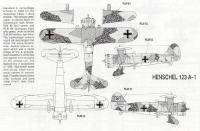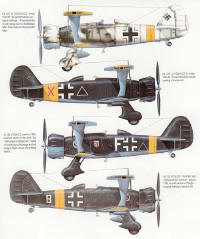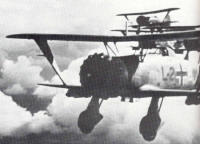Profiles and Color Schemes
 (Ref.a, pag.239)
(Ref.a, pag.239)
 (Ref.c, pag.34)
(Ref.c, pag.34)
 (Ref.a, pag.240)
(Ref.a, pag.240)
 (Ref.b, pag.42)
(Ref.b, pag.42)
Hs-123A from 5.(SchLacht)/LG 2 in 1941-1942. Note
the RLM 70 showing up around the infantary assault badge (partially obscured
by the wing strut), the individual aircraft letter and the swastika
 (Ref.d, rear cover inside)
(Ref.d, rear cover inside)
Photos
Poland, Norway and the West
The II./LG 2 under Major Spielvogel flew fighter
opertions almost endlessly, and almost without losses. The Hs-123 proved to
beeasy to maintain and was remarkably able to withstand fire.

 (Ref.a,
pag.32)
(Ref.a,
pag.32)
Since the Hs-123 was supposed to be phased out as
a combat plane as early as 1939, the planes of the II./LG 2 were not painted
with the new 70/71 green camouflge paint.
 (Ref.a, pag.40)
(Ref.a, pag.40)
In the Summer, the II./LG 2 had more than forty
Hs-123 planes, which had meanwhile been painted 70/71 green. At the left is
the plane of the commander, Captain Weiss. Note the double chevrons on the
wing and the white stripe along the rear of the fuselage.
The Mediterranean Theatre of War
II./LG 2 had three units of Bf 109E-4 and E-7 and
one unit of Hs-123. II./LG 2 was subordinated to the pursuit-bomber unit of JG
27.
 (Ref.a, pag.63)
(Ref.a, pag.63)
Hs-123 of the II./LG 2 in dark green RLM 71 paint,
with yellow motor cowling and rudder. The aircraft have the black triangle and
the infantary assault emblem.
 (Ref.a, pag.66)
(Ref.a, pag.66)
In the Balkan campaign the wheel covers were
removed because they quickly bent while rolling on unpaved fields.
References:
a) Stuka by Gebhard Aders, Werner Held, 1989
Shiffer Publishing. ISBN: 0-88740-216-X
b) Wing Masters Magazine, Nº 17 July-August 2000
c) Luftwaffe 1935-1945 Pt.1 - Camouflages &
Markings 1 (Eng. Text) by Jaroslaw Wróbel, 1994 AJ-Press. ISBN: 83-86208-08-2
d) Luftwaffe 1935-1945 Pt.3 - Camouflages &
Markings 3 (Eng. Text) by Robert Michulec, 1996 AJ-Press. ISBN: 83-86208-49-X
On to page 2
 (Ref.a, pag.239)
(Ref.a, pag.239)